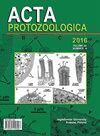在一个浅的、肥厚的水库中,纤毛虫群落与蓝藻水华的相互作用
IF 1.5
4区 生物学
Q4 MICROBIOLOGY
引用次数: 13
摘要
在中欧斯洛伐克的一个浅层肥厚水库中,研究了纤毛虫群落对蓝藻华的反应。纤毛虫群落的季节动态与水华形成过程呈负相关。在蓝藻水华尚未完全发育的春季,纤毛虫的数量和丰度最高,而在夏初水华达到顶峰时,纤毛虫的数量和丰度都急剧下降。因此,蓝藻开花显著降低了纤毛虫群落的多样性和公平性:许多稀有和零星物种消失,少数常见分类群蓬勃发展和占主导地位。尽管如此,这些领先的纤毛虫形成了一个功能多样化的组合,其成员大多表现出积极的同时期相互作用,只有很少的时移相互作用。有细滤食性(Cinetochilum margaritacum、Dexiotricha granulosa、尾草草皮虫和Spirostomum teres)放牧异养细菌和picocyanobacteria,杂食性细至粗滤食性(Frontonia leucas)以及寻找单个猎物的猎人(Coleps hirtus、Holophrya teres和Loxophyllum helus)。此外,在储层底部发育了一个相对丰富的厌氧群落,包括各种细菌甲虫和斜鳃虫。我们的研究文件表明,纤毛虫形成功能多样的群落,具有控制肥厚水库蓝藻华的潜力。本文章由计算机程序翻译,如有差异,请以英文原文为准。
Interaction of ciliate communities with cyanobacterial water bloom in a shallow, hypertrophic reservoir
The response of ciliate communities to cyanobacterial bloom was investigated in a shallow, hypertrophic reservoir in Slovakia, central Europe. Seasonal dynamics of ciliate communities corresponded negatively with course of water bloom formation. The highest numbers and abundances of ciliate species occurred during the spring season when cyanobacterial bloom was not fully developed, while there was an abrupt decrease in both numbers and abundances at the beginning of summer when water bloom culminated. Cyanobacterial blooming thus significantly lowered diversity and equitability of ciliate communities: many rare and sporadic species disappeared and few common taxa flourished and dominated. Nonetheless, these leading ciliates formed a functionally diverse assemblage whose members showed mostly positive contemporaneous and only rarely time-shifted interactions. There were fine filter feeders (Cinetochilum margaritaceum, Dexiotricha granulosa, Paramecium caudatum and Spirostomum teres) grazing heterotrophic bacteria and picocyanobacteria, omnivorous fine to coarse filter feeders (Frontonia leucas) as well as hunters (Coleps hirtus, Holophrya teres and Loxophyllum helus) looking for an individual prey. Also a comparatively rich, anaerobic coenosis comprising various bacterivorous armophoreans and plagiopyleans, developed at the bottom of the reservoir. Our study documents that ciliates form functionally diverse communities with potential to control cyanobacterial blooms in hypertrophic reservoirs.
求助全文
通过发布文献求助,成功后即可免费获取论文全文。
去求助
来源期刊

Acta Protozoologica
生物-微生物学
CiteScore
2.00
自引率
0.00%
发文量
8
审稿时长
>12 weeks
期刊介绍:
Acta Protozoologica - International Journal on Protistology - is a quarterly journal that publishes current and comprehensive, experimental, and theoretical contributions across the breadth of protistology, and cell biology of Eukaryote microorganisms including: behaviour, biochemistry and molecular biology, development, ecology, genetics, parasitology, physiology, photobiology, systematics and phylogeny, and ultrastructure. It publishes original research reports, critical reviews of current research written by invited experts in the field, short communications, book reviews, and letters to the Editor.
 求助内容:
求助内容: 应助结果提醒方式:
应助结果提醒方式:


